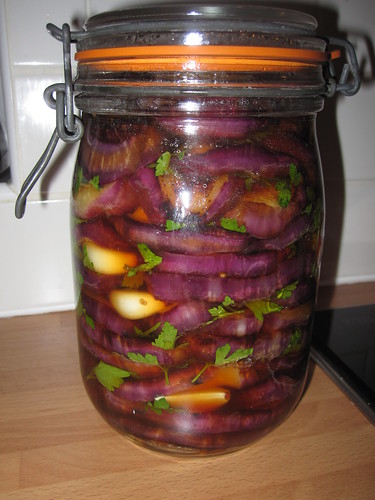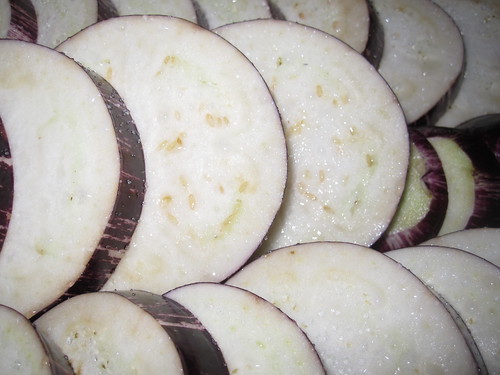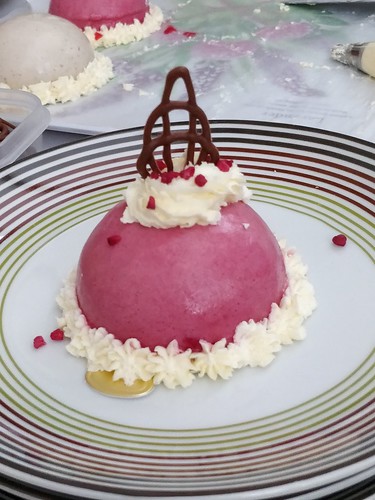In the recent Great British Bake Off, one of the technical challenges was blancmange, which seems to be a very 70's dessert and appears to be dreaded by most people. At the GBBO, they mentioned this is mainly because in the 70's it came in the form of a sachet of powder that would be mixed with a liquid and allowed to set. But the contestants had to make a "proper" one, from scratch.
As it is now nearing the time for my in-laws' wedding anniversary, Lundulph has volunteered me to make a dessert and having watched the GBBO blancmange, I was rather intrigued by it. Thus I spent my short time on the train to and from work, to find some suitable recipes.
A key requirement is that I need to avoid gelatine - various members of the family do not approve of gelatine and for different reasons, so I try to be accommodating and use agar agar. The following two recipes both list this as the principle jelling ingredient, though mention gelatine as an alternative.
Lundulph also watched the GBBO show and as he's now constantly hungry due to his daily early morning swimming, has been asking me to make it. I'm not sure he'll like it, he seems to have fond memories of the powdered version from the 70's for some reason. Thus this is a dress rehearsal to try out the two chosen recipes and gain Lundulph's approval.
Coconut Blancmange
Adapted from this one
zest from 1 lime
8 dl coconut milk
3.3 dl sweetened condensed milk (one can of 397 g)
¼ tsp ground cinnamon
⅛ tsp salt
1 tbsp vanilla paste
1 tbsp rum
2.5 tbsp agar agar flakes
Method
- Measure/weigh the ingredients. Butter the mould well, but make sure there are no lumps left.
- Place lime zest, coconut milk, condensed milk, cinnamon, salt and vanilla paste in a saucepan.
- Place on medium-high heat and bring to the boil, while stirring.
- Let simmer for a few minutes, then strain the liquid and return to the saucepan and the hob.
- Add the rum and stir through.
- Sprinkle the agar agar over the mixture and stir through. Bring to the boil once more and simmer until it has dissolved completely, while stirring constantly. It may take up to 10 minutes.
- Pour into the mould of your choice and leave to cool to room temperature, then refrigerate for a few hours or overnight.
- If not able to fit everything into the mould, pour left-overs in a Pyrex bowl, cover the surface with cling film and keep in the oven at 40°C until the previous batch has set and can be de-moulded.
On the original website, the photos look very pretty, the blancmange is really pure white, apart from the vanilla seeds. This is not the case with mine, the vanilla paste and the dark rum I used, along with the lime zest have made the mixture almost latte coloured. The original recipe also stated to add finely grated fresh coconut and I couldn't grate it as finely as I wanted, so there were bits in the final result, which didn't work well at all. Thus I've added the straining step.
There was also an error on parentheses placement I think, because it worked out to say to soak the agar agar in a bowl of cold water, when this was probably for the gelatin leaves. In my first attempt, I mistakenly soaked the agar agar and I had to drain it from the liquid before adding to the blancmange. I hope it dissolved OK too, it was hard to tell. The flavour was very good, I made 6 individual portions in a silicone semi-spherical mould and the rest went into my bundt cake tin. I didn't butter the silicone mould, I'm hoping it would be easy enough to peel off. When using agar agar, things set rather quickly when they cool, so in theory the blancmange would be ready to eat when it's cooled down, however, it works a lot better when it's well chilled in the fridge first.
We tried one of the individual portions out for breakfast dessert. I was worried there was too much agar agar and it would have set quite hard, in fact almost the opposite - it was very creamy and pudding-y. To the point that one of the individual portions wouldn't come out, the second one did and I have 4 more to work out the technique for getting them out. I've made adjustments in the recipe amounts above, but keep in mind, it is still quite sweet. The amount of lime zest was quite over-powering, so I've reduced that. But a key thing with blancmange I think is that it needs to be as smooth as possible - like panna cotta. Crunchy bits can be added to the decorations, not inside.
Lundulph's thoughts were that it was on the small side, but that it was very rich, so with the odd biscuit and some fresh tangy fruit, it would work quite well.
Raspberry blancmange
Adapted from this one.
450 g raspberries
1 tsp vanilla extract/paste
50 g golden caster sugar
2 dl semi-skimmed milk
1 dl double cream
0.5 dl maple syrup
2.5 tbsp agar agar
1 tbsp raspberry liqueur
Method
- Butter a jelly mould or bundt cake tin well, but without leaving any lumps.
- Puree the raspberries, vanilla and sugar and sieve as much as possible to remove the pips.
- Place the milk, cream and agar agar in a large saucepan and bring to a simmer, stirring constantly so it doesn't burn.
- Add the almonds and maple syrup and keep simmering and stirring for 2 - 3 minutes or until the agar agar has dissolved.
- Remove the milk mixture from the heat and stir in the smooth raspberry puree and the liqueur.
- Pour the mixture into the jelly mould and let cool to room temperature, before refrigerating for a few hours or overnight.
Also in this case, I made 6 individual portions and the rest went into the bundt cake tin on top of the coconut blancmange. As it turned out, the bundt tin is not a suitable vessel for storing blancmange and it had some dark blue blotches on it, so I decided not to risk eating it, but threw it away - glass mould is the way to go. Again, the original recipe had ground almonds and in my first attempt I added these and I felt they detracted rather than added to the overall experience, so I've dropped them.
For decoration, whipped cream and fresh fruit to match the flavour of the blancmange will probably work well or delicate chocolate decorations.
The second batch I made was for a family gathering, but I had a busy week ahead of me, so I made these well in advance and froze them. This sort of worked, but when the portions were thawed, they released some of their juices and had also gone a little grainy, not as smooth as before freezing. I placed them on thin, dry wafers with the aim to soak this up, which worked, mostly, but for future reference, don't freeze.
At the GBBO they made biscuits called langues des chats, so I decided to try these out as well.
Langues des chats
40 g unsalted butter at room temperature
40 g icing sugar
¼ tsp almond extract or orange extract
1 large egg white
40 g plain flour
pinch of salt
Method
Whip together the butter and icing sugar until light and fluffy - this can be tricky with these small amounts.
Whisk in the extract of choice and the egg white.
Sift in the flour and salt and whisk in to get a smooth batter.
Transfer the batter to a piping bag and pipe straight lines, 6 - 8 cm long on baking paper, leaving about 3.5 cm between each.
Place in the fridge for 15 minutes and pre-heat the oven to 160 °C fan assisted.
Bake for 8 - 10 minutes, until the edges go golden, but the middle remains pale.
Remove from the oven, let cool for a couple of minutes on the baking sheet, then transfer to a cooling rack.
Store in an air-tight container.
I made two batches. The GBBO instructions said to make 12 x 8 cm long biscuits, which was perhaps the requirement for the competition, but the amount of batter is enough for more than 12.
A note on agar agar. In the recipes above I used flakes, but when I repeated my recipes for our Christmas celebration in Sweden, I had powdered agar agar. A quick google resulted in 1 tbsp flakes = 1 tsp powder. This is not entirely accurate as the blancmange set a bit too much. For 2.5 tbsp of agar agar flakes, I'd substitute 2 tsp agar agar powder.

 >
>









